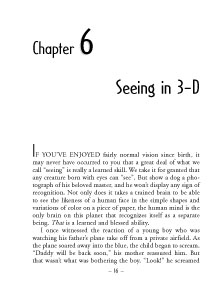 |
| Mr. Brady realized quickly that vision is a learned skill, as much related to mental perception as to the visual information relayed by the eyes. "If you've enjoyed fairly normal vision since birth, it may never have occurred to you that a great deal of what we call 'seeing' is really a learned skill." (pg. 19) People must actively learn to see differently after the loss of an eye. "In the same way, partial loss of the vision you've learned and have used all your life entails a whole new learning experience. But there's a tendency among persons who've always had normal vision to make the transition from two eyes to one by letting nature take its course. This unorganized approach will eventually get you there, but you can speed it up and smooth it out significantly by doing a bit of homework. The first thing you need to understand is the nature of the change that has taken place. What is it, exactly, that you have lost? And what is it that you have left?" (pg. 20) Chapter 1. An Unhappy Landing Chapter 2. An Awkward Takeoff Chapter 3. Jolts of Reality Chapter 4. Flying High Chapter 5. How About You? Chapter 6. Seeing in 3-D—How It Works Chapter 7. What Has Changed? Chapter 8. Getting Back to 3-D Chapter 9. Avoiding Problems and Possible Mistakes Chapter 10. In the Driver’s Seat Chapter 11. The Active Life Chapter 12. Let Technology Help Chapter 13. Keeping the Good Eye Good Chapter 14. Seeing to Your Looks Chapter 15. Eye-making (Ocularistry) Chapter 16. Driving and Piloting Licenses Chapter 17. For Parents Only Chapter 18. Senior Class Chapter 19. In Good Company Glossary Resources |